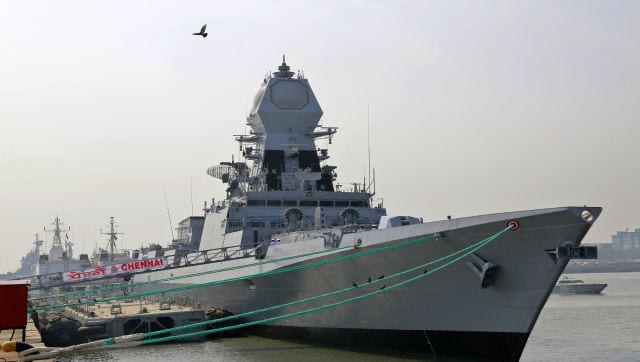They are called the Guardians of the Seas and the Indian Navy is living up to its name. Amid rising piracy attacks and drone strikes by Houthi rebels, the maritime force has now deployed over 10 top-of-the-line warships in the strategic waters of the Arabian Sea and the Gulf of Aden.
This comes days after the naval forces rescued 21 crew members aboard the Liberia-flagged merchant vessel MV Lila Norfolk, which had been hijacked by pirates off the coast of Somalia.
Let’s take a closer look at how the warships deployed and how they will secure the high seas.
Enhanced surveillance in the Arabian Sea
From having a mere two warships in the Arabian Sea for anti-piracy duties at the beginning of December last year, the deployment was increased to five by the middle of the same month, and now stands at 10 after recent attacks.
Last month, the Indian Navy had announced that it would deploy INS Kolkata, INS Kochi, INS Mormugao, INS Chennai and INS Visakhapatnam into the Arabian theatre. According to a report by the Hindustan Times, INS Kolkata was deployed on the mouth of Red Sea, INS Kochi is situated south of Yemen Socotra Island, INS Mormugao is in west Arabian Sea with Chennai in Central Arabian Sea and INS Visakhapatnam was tasked to patrol the north Arabian Sea.
Now, multi-role frigates like INS Talwar and INS Tarkash will also be deployed in the region to ensure safe passage of ships.
On 6 January, Navy Chief Admiral R H Hari had said that anti-piracy and anti-drone operations had been enhanced in the region and more such action would be taken in the near future to tackle the challenges.
He had further directed to carry out thorough checks on the suspicious boats to ensure the safety of our merchant vessels and mariners.
Moreover, each of the deployed warships come with the presence of Marine Commandos (MARCOS). The Times of India has also reported that apart from the presence of the warships, regular ISR (intelligence, surveillance and reconnaissance) missions are also being flown by P-8I long-range maritime patrol aircraft and unarmed MQ-9B Sea Guardian drones are also patrolling the waters.
Recent spate of attacks in the Arabian Sea
The deployment of warships and increased surveillance in the waters come at a time when there’s been a spate of attacks.
As recently as last week, MV Lila Norfolk, a bulk carrier with about 15 Indian crew members, had been taken hostage near Somalia’s coast. Almost immediately, the Indian Navy deployed INS Chennai and in a daring operation, Indian marine commandos intercepted, then boarded the hijacked ship, and rescued the crew.
Prior to this, on 23 December last year, MV Chem Pluto – a chemical/ oil tanker with a crew of 21 Indians and a Vietnamese – was hit by a drone in the Arabian Sea while en route to New Mangalore port. The Indian Navy after studying the area of attack and debris found on the ship pointed to a drone attack, which was also corroborated by the US Pentagon. A Pentagon spokesperson had claimed that the MV Chem Pluto was hit “a one-way attack drone fired from Iran”.
A day later, a Gabon-flagged commercial oil tanker, MV Sai Baba, on its way to India with 25 crew members, all of them Indians, also came under drone attack in the southern Red Sea.
And on 14 December last year, Malta-flagged vessel MV Ruen, with 18 on board, had been hijacked in the Arabian Sean. Days later, one of the crew members – who had sustained a bullet injury to his shoulder during the piracy incident – was moved by the Navy to INS Kochi for medical assistance. According to the New Indian Express, MV Ruen continues to remain docked off the Somalia coast.
Also read: Will find MV Chem Pluto attackers even from the depths of seas: Defence Minister Rajnath Singh
Not a part of ‘Operation Prosperity Guardian’
Interestingly, India’s increased surveillance comes at a time when the United States has launched a multi-national naval coalition called Operation Prosperity Guardian. India, despite being a key ally of Washington, has not committed to the operation.
Also read: How Houthi attacks in the Red Sea could affect everyday life
When asked about the same, a top Navy official had told The Week: “At the moment, there is no reason to involve ourselves in the Operation as our interests are being protected. But of course, if we find that they are being threatened at any point of time, we are ever-ready to do the needful.”
As of now, Operation Prosperity Guardian involves the navies of Bahrain, Canada, France, Italy, Netherlands, Norway, Seychelles, Spain, UK and US. The task force falls under the Combined Maritime Forces, a multinational alliance tasked with defending the world’s shipping lanes.
The Operation came into effect as the Houthis have attacked multiple merchant vessels and forced companies to suspend routes through the region.
With inputs from agencies
Link to article –
How Indian Navy’s warships are battling pirates, drones in the Arabian Sea





